R.J. Stowell's Blog: rjsomeone, page 17
September 19, 2020
The Muse of Liverpool and L.A.
 When the Beatles finished the recording of Sgt. Pepper in late April 1967 (the 21st to be exact), they retired, the mythology goes, to Mama Cass's flat in Chelsea at around 2am. We’ve talked before about the Gertrude Stein of Laurel Canyon, but Cass Elliot’s hand in music was far-reaching. With acetate of the LP in hand, the Beatles piled into the apartment, Cass sprawled across the settee – can you picture it? – the mustachio'd Fab Four sitting cross-legged on the floor. Ringo, I'm speculating the details here, put the LP on the phonograph, opened the windows and the incredible strains of Sgt. Pepper & Co. wafted magically, Peter Maxily down onto the streets of sleepy London. It's one of rock's beautiful vignettes, and maybe it's even true. The Beatles immersed London, and the world at large, in an incredible feat of psychedelic realism. (Indeed, I'm coining the phrase right now.)
When the Beatles finished the recording of Sgt. Pepper in late April 1967 (the 21st to be exact), they retired, the mythology goes, to Mama Cass's flat in Chelsea at around 2am. We’ve talked before about the Gertrude Stein of Laurel Canyon, but Cass Elliot’s hand in music was far-reaching. With acetate of the LP in hand, the Beatles piled into the apartment, Cass sprawled across the settee – can you picture it? – the mustachio'd Fab Four sitting cross-legged on the floor. Ringo, I'm speculating the details here, put the LP on the phonograph, opened the windows and the incredible strains of Sgt. Pepper & Co. wafted magically, Peter Maxily down onto the streets of sleepy London. It's one of rock's beautiful vignettes, and maybe it's even true. The Beatles immersed London, and the world at large, in an incredible feat of psychedelic realism. (Indeed, I'm coining the phrase right now.) 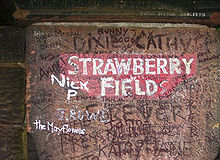 McCartney’s Fixin' a Hole is a psychedelic masterpiece, as is Lennon's Lucy, but the undercurrent in the LP is the realism of a girl leaving home ("She's Leaving Home" so expertly weaving the tale from both sides of the generation gap) and a meter maid and the mundane episodes of the News of the Day. The LP's inspiration, whether stemming from out of dance halls or Lonely Hearts Clubs or Lennon's disassociation from family, are firmly rooted in a British Realism that wouldn't be lost on Emily Bronte. There are naysayers of course. Aimee Mann, you know the "voices carry' girl said, "I'm burnt out on it [that part I'll buy]. Its influence has been so vast and profound, but it lacks emotional depth." She prefers the stylings of Elliot Smith and Fiona Apple. So she’s stupid – hush, hush, Aimee – despite AM's fondness for both Smith and Apple. Mostly though, you and I know, this is the rock masterpiece.
McCartney’s Fixin' a Hole is a psychedelic masterpiece, as is Lennon's Lucy, but the undercurrent in the LP is the realism of a girl leaving home ("She's Leaving Home" so expertly weaving the tale from both sides of the generation gap) and a meter maid and the mundane episodes of the News of the Day. The LP's inspiration, whether stemming from out of dance halls or Lonely Hearts Clubs or Lennon's disassociation from family, are firmly rooted in a British Realism that wouldn't be lost on Emily Bronte. There are naysayers of course. Aimee Mann, you know the "voices carry' girl said, "I'm burnt out on it [that part I'll buy]. Its influence has been so vast and profound, but it lacks emotional depth." She prefers the stylings of Elliot Smith and Fiona Apple. So she’s stupid – hush, hush, Aimee – despite AM's fondness for both Smith and Apple. Mostly though, you and I know, this is the rock masterpiece.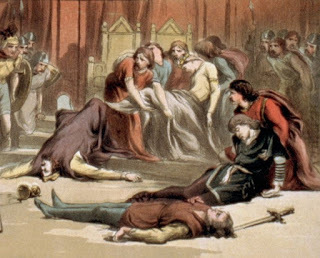 That same year, The Doors followed a different muse. Within the tracks of The Doors, Morrison unleashes Greek tragedy (and the mother thing, no less, from Oedipus Rex), Willie Dixon-styled let's fuck ambiguities, millennial Celtic myths and a psychedelia the challenged us all to break on through to the other side and to read the likes of Artaud, Brecht and Huxley. Of course, The Doors owe even their name to Morrison's muse, a nod to Aldous Huxley’s The Doors of Perception, which chronicles the author's experience of taking the mind-altering drug mescaline. The literary reference goes even deeper as Huxley's title is taken from a line in William Blake's "The Marriage of Heaven and Hell": "If the doors of perception were cleansed, everything would appear to man as it is: infinite."
That same year, The Doors followed a different muse. Within the tracks of The Doors, Morrison unleashes Greek tragedy (and the mother thing, no less, from Oedipus Rex), Willie Dixon-styled let's fuck ambiguities, millennial Celtic myths and a psychedelia the challenged us all to break on through to the other side and to read the likes of Artaud, Brecht and Huxley. Of course, The Doors owe even their name to Morrison's muse, a nod to Aldous Huxley’s The Doors of Perception, which chronicles the author's experience of taking the mind-altering drug mescaline. The literary reference goes even deeper as Huxley's title is taken from a line in William Blake's "The Marriage of Heaven and Hell": "If the doors of perception were cleansed, everything would appear to man as it is: infinite." 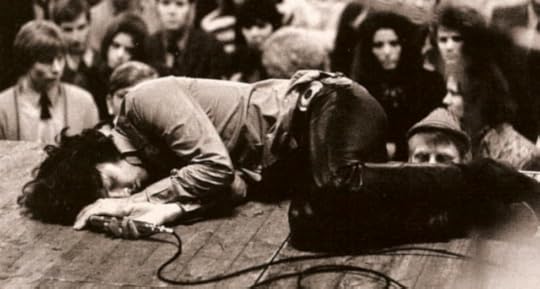 In 1969, Morrison would write (and distribute to concertgoers at the Aquarius Theater in the form of a flyer – July 21st) "Ode to L.A., While Thinking of Brian Jones, Deceased," which, in addition to depicting the first truly publicized death of the rock era, was a throwback to Willy the Shake. Morrison writes, "I'm a resident of a city/ They’ve just picked me to play/ the Prince of Denmark…" The poet feels himself Hamlet – and although in our modern age the idea may seem banal, the existential problem of to-be-or-not-to-be, to exist or not, is one of poetry's essentials. And indeed, death is central in Morrison's poetry.
In 1969, Morrison would write (and distribute to concertgoers at the Aquarius Theater in the form of a flyer – July 21st) "Ode to L.A., While Thinking of Brian Jones, Deceased," which, in addition to depicting the first truly publicized death of the rock era, was a throwback to Willy the Shake. Morrison writes, "I'm a resident of a city/ They’ve just picked me to play/ the Prince of Denmark…" The poet feels himself Hamlet – and although in our modern age the idea may seem banal, the existential problem of to-be-or-not-to-be, to exist or not, is one of poetry's essentials. And indeed, death is central in Morrison's poetry. Morrison as a true visionary poet foresaw volumes (at least in his own mind) and predicted his own death (or talked about it a lot - how's that for vaguery?). "Ode to L.A.," devoted to Brian Jones, whose mysterious death in a swimming pool influenced Morrison, provoked him into writing a poem languorous with images of water, pools and dead bodies: "…Poor Ophelia/ All those ghosts he never saw/ Floating to doom/ On an iron candle/ Come back, brave warrior/ Do the dive/ On another channel". I make no reference to brilliance here, there is none, only to Morrison's use of the muse.
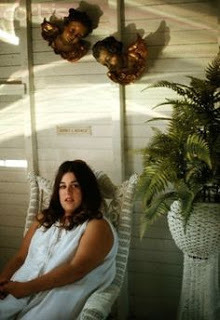 Another reticent image in Morrison's poetry is the "Far Arden." Far Arden is known to the reader from Shakespeare's As You Like It. In Morrison's poetry Far Arden symbolizes freedom, joy and music, a mystic forest where songs and dances rule: "Ladies & gentlemen:/ please attend carefully to these words & events/ It’s your last chance, our last hope./ In this womb or tomb, we’re free of the swarming streets." Morrison interpreted Shakespeare's images through his own scope of vision as a poet born in the 20th century whose poetic style was worked out in existential philosophy combined with the tradition of visionary poets, Indian religion and the American avant-garde of the 50s. Morrison was worlds away from the Brit Realism of Lennon/McCartney, but equally far away from the naturalist style of the Laurel Canyon set with whom he lived among, often venturing up the canyon to Mama Cass’s house, the two having known one another since high school in Alexandria Virginia. Though not particularly chummy in the Canyon, one can imagine the same muse in Cass that the Beatles encountered.
Another reticent image in Morrison's poetry is the "Far Arden." Far Arden is known to the reader from Shakespeare's As You Like It. In Morrison's poetry Far Arden symbolizes freedom, joy and music, a mystic forest where songs and dances rule: "Ladies & gentlemen:/ please attend carefully to these words & events/ It’s your last chance, our last hope./ In this womb or tomb, we’re free of the swarming streets." Morrison interpreted Shakespeare's images through his own scope of vision as a poet born in the 20th century whose poetic style was worked out in existential philosophy combined with the tradition of visionary poets, Indian religion and the American avant-garde of the 50s. Morrison was worlds away from the Brit Realism of Lennon/McCartney, but equally far away from the naturalist style of the Laurel Canyon set with whom he lived among, often venturing up the canyon to Mama Cass’s house, the two having known one another since high school in Alexandria Virginia. Though not particularly chummy in the Canyon, one can imagine the same muse in Cass that the Beatles encountered.
Published on September 19, 2020 05:45
September 18, 2020
September 17, 2020
Led Zeppelin III
 Modern culture has ripped the Mona Lisa right out of us; her image so ingrained in our collective psyche that we barely stop to even look. In the 1919 Marcel DuChamp recreated the Mona Lisa with a moustache and the caption "L.H.O.O.Q." which when pronounced phonetically (in French, of course) translates as, "She's got a hot ass." It was his way of making us look again. Often ignored in favor of the second and fourth albums, LZIII (AM7) is an unrecognized jewel. Zep fans who don't migrate here when ZOSO is just one listen away from intolerable, when "Stairway" is as timeworn as La Gioconda, have missed out on their fave band's most accessible LP. III is the Mona Lisa with a hot ass.
Modern culture has ripped the Mona Lisa right out of us; her image so ingrained in our collective psyche that we barely stop to even look. In the 1919 Marcel DuChamp recreated the Mona Lisa with a moustache and the caption "L.H.O.O.Q." which when pronounced phonetically (in French, of course) translates as, "She's got a hot ass." It was his way of making us look again. Often ignored in favor of the second and fourth albums, LZIII (AM7) is an unrecognized jewel. Zep fans who don't migrate here when ZOSO is just one listen away from intolerable, when "Stairway" is as timeworn as La Gioconda, have missed out on their fave band's most accessible LP. III is the Mona Lisa with a hot ass.Riff rock along the lines of "Immigrant Song", "Celebration Day" and "Out on the Tiles" is in check, but the word of the day is subtlety. "Friends," "Tangerine" and "That's the Way" are acoustic highlights, celebrating English folk, nonstandard guitar tunings and a general adoration for the rustic life. If you've never heard this one, you owe it to yourself to pick it up and discover a whole different side of Led Zeppelin. This one's not there to rock you senseless.

Pretty ironic that fans and critics in 1971 were so mortified by Zep's turn toward the Dark Side (i.e. the scandalous use of, gulp, acoustic instrumentation). After all, the true roots music for an English musician isn't the harmonicas and dobros of the Mississippi Delta, it comes from the lutes and dulcimers of traditional English folk. In that context, Led Zeppelin III is as close as the band ever got to putting out an "English Soul" LP. "Gallows Pole" is the best example of traditional folk of the Zeppelin ilk. How many other hard rocking numbers can you name that feature banjo, for God's sake? III is arguably Zeppelin's most consistently listenable album, if only because the songs haven't been ruined by incessant FM airplay over the years.
 Led Zeppelin III was part a response to critics who called the band one-sided and over the top and part a product of Jimmy Paige's and Robert Plant's love of "music for hippie bookstores" such as American songwriters like Joni Mitchell and Love's Arthur Lee or Brit folk bands like Fairport Convention and Steeleye Span. After nearly two years of constant touring, the band retreated to the cottage where Robert Plant summered with his family when young. According to music journalist Jonathan Wingate, Led Zeppelin III's "folky" feel could only have been created somewhere like Bron Yr Aur (pron. bron-rar): "After Led Zeppelin I and II, the fans were expecting another beefy album driven by heavy guitar riffs. But without any electricity to power big amplifiers, what they actually came up with was something which sounded much more acoustic and pastoral," he said. "When you listen to it you just have to close your eyes and you can hear the echoes of this remote country house. It's an album which you can imagine being performed around a crate of beer in front of a roaring log fire." Yeah, I'm going to try that. Led Zeppelin III is like finding a long forgotten LP among the stacks and never before realizing its power and subtlety.
Led Zeppelin III was part a response to critics who called the band one-sided and over the top and part a product of Jimmy Paige's and Robert Plant's love of "music for hippie bookstores" such as American songwriters like Joni Mitchell and Love's Arthur Lee or Brit folk bands like Fairport Convention and Steeleye Span. After nearly two years of constant touring, the band retreated to the cottage where Robert Plant summered with his family when young. According to music journalist Jonathan Wingate, Led Zeppelin III's "folky" feel could only have been created somewhere like Bron Yr Aur (pron. bron-rar): "After Led Zeppelin I and II, the fans were expecting another beefy album driven by heavy guitar riffs. But without any electricity to power big amplifiers, what they actually came up with was something which sounded much more acoustic and pastoral," he said. "When you listen to it you just have to close your eyes and you can hear the echoes of this remote country house. It's an album which you can imagine being performed around a crate of beer in front of a roaring log fire." Yeah, I'm going to try that. Led Zeppelin III is like finding a long forgotten LP among the stacks and never before realizing its power and subtlety.
Published on September 17, 2020 05:28
Led Zeppelin - The Carousel - An Excerpt from Miles From Nowhere
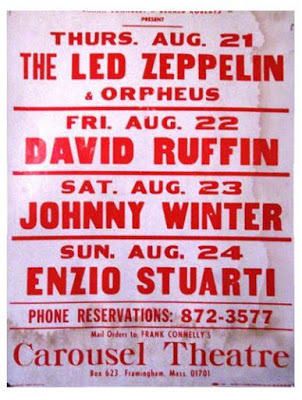 To my delight and despite my funk, the Carousel was a circus tent in the middle of a grassy field. Had there been elephants, I wouldn’t have been surprised. There were no cars in the lot, only a van backed up to the tent. Inside was a low stage and a wall of amps.
To my delight and despite my funk, the Carousel was a circus tent in the middle of a grassy field. Had there been elephants, I wouldn’t have been surprised. There were no cars in the lot, only a van backed up to the tent. Inside was a low stage and a wall of amps.I was tired and uncomfortable. I fell asleep in the back of the van. When I awoke it was dark and the big top was lighted from within, an atmospheric glow that made it seem sleepy and unreal. I got out of the van and a guy was leaning against my door. He apologized. His friends were sitting on the hood of a powder blue Corvair, passing around a joint. I figured I’d share; it’s what you do.
They were nice people. Big Zeppelin fans. One had a guitar. He was trying to play some blues thing and getting frustrated. Then he played “Embryonic Journey,” an instrumental from the Jefferson Airplane. I liked watching his fingers. He played it expertly. I said, “That was great, man.”
I figured I’d get something to eat. They had a snack bar like a drive-in theater, with hamburgers and hot dogs wrapped in tin foil bags. I walked over with the guy who’d been leaning on my car and his girl, a pretty thing who didn’t say a word. If she was mute it would have made sense. But she had a pretty smile.
Turned out I didn’t really want anything. I didn’t feel well. I got a chocolate milk and some fries, and I lost them in line. The lady at the cash register said, “You okay?” I shrugged and gave her a quarter.
Across the way was the ticket booth, just like at an amusement park. Tickets were $4.00, and I went inside. It was crowded, but when you’re alone you can excuse your way through, and I laced my way in and out to stake my claim in the front by a bank of amps. The stage was low enough to sit on and I sat looking out at the masses. It was a different crowd than Woodstock. Woodstock was a hippie paint-by-numbers; this seemed like something from our future, what we could expect from the 70s; the difference like chalk and cheese. There weren’t any dandies or flower girls. The guys wore flared pants and tight t-shirts, their hair bushy and wild, and the girls, wild prints and blouses that accentuated their figures, braless and formfitting. The atmosphere made Woodstock seem like the end of something, and this, here in a circus tent, was the beginning of something else.
I didn’t know anything about the Zeppelin. Don the Hippie used to play the LP. It was loud and voracious, brash and beautiful as well. I didn’t know the names of the songs or the names of the band members, only that it was super bluesy and passionate.

The band came out on the stage. They weren’t but a few feet away. I recognized the guitarist from The Yardbirds. He had a very distinctive look. He wore crushed velvet pants and a peach-colored faded Henley, and the singer had flared jeans and a gauzy shirt like Lori wore in hippie-mode. He had shaggy hair below his shoulders. He was handsome, almost pretty.
The announcer said, “Ladies and Gentlemen, please welcome the Led Zeppelin,” and immediately they started to jam; a crazy, off-kilter blues song with a frantic harmonica. I guess I’m a little naïve, I guess I over-simplify things, but in my mind it really was about a train. The imagery in my head was a railroad semaphore, its lights flashing, the steam whistle of a locomotive in the distance.
My two new friends were over on the other side of the stage really rockin’ out and singing the refrain, “Train kept a-rollin’, all night long.” He was standing behind her with his hands on her waist and he was grinding against her. I got it, suddenly, how wrong I was.And when it wasn’t just raw passion, the singer moaned about lost love, unabashedly sorry for himself, and lonesome. These songs were like nothing ever heard before. It was sheer power, each member of the band unparalleled in what they did; and not only because no one else was doing it. The music was a ritual, with the band, like magicians or shamans, giving off energy, the audience taking the energy in, then offering it back. It really did seem like Woodstock was yesterday, and here in front of me was tomorrow. They played a lovely if convoluted instrumental called “Black Mountain Side,” and the audience, a thousand hero worshippers, were transfixed, silent and in awe. I was standing by a huge rack of amps and each note would reverberate inside me, negating how awful I felt. Suddenly, I was weak and out of it. I sat on the edge of the stage and took a breath. I closed my eyes and opened them again. I saw Jimmy Page there before me, his black and white Danelectro morphing in and out of focus.
It was the last thing I remember.
Published on September 17, 2020 05:27
September 14, 2020
Station to Station (AM8)
 Bowie's vocal tour de force is a restless album jumping genres from track to track. The Thin White Duke is like a manic host insisting you see all the city's clubs in just one night. Epic mounds of cocaine-induced genre jitters, they say, but can vocals this restrained and cadenced be achieved in a dopamine frenzy? You wouldn't think. Bowie moves from funk to funky and ties it all up with his WW ballads, "Word on a Wing" and Dimitri Tiomkin's Oscar nominated "Wild is the Wind," which drip with enough melodrama to make Roy Orbison cry. What's missing here? Nothing, and that is the issue. We've got funky, we've got Motorik; it's Philly R&B though Euro-centric. It's Earl Slick and Roy Bitten and Carlos Alomar who said, "It was one of the most glorious albums that we've ever done ... We experimented so much on it," and hardly knew when to stop. NME described it as having "an air of regret for missed opportunities and past pleasures." It's just all over the place: it's great then it's not, then it apologizes and makes up for it, overdoes it again. It was indeed drug-induced genius, but does that belittle it? Face it, Dark Side of the Moon was all the more fabulous because you were just so high. Bowie stated that he only "knew he was in L.A., because he had read that he was in L.A." It's an album that came out of a stupor. So do most of our best memories.
Bowie's vocal tour de force is a restless album jumping genres from track to track. The Thin White Duke is like a manic host insisting you see all the city's clubs in just one night. Epic mounds of cocaine-induced genre jitters, they say, but can vocals this restrained and cadenced be achieved in a dopamine frenzy? You wouldn't think. Bowie moves from funk to funky and ties it all up with his WW ballads, "Word on a Wing" and Dimitri Tiomkin's Oscar nominated "Wild is the Wind," which drip with enough melodrama to make Roy Orbison cry. What's missing here? Nothing, and that is the issue. We've got funky, we've got Motorik; it's Philly R&B though Euro-centric. It's Earl Slick and Roy Bitten and Carlos Alomar who said, "It was one of the most glorious albums that we've ever done ... We experimented so much on it," and hardly knew when to stop. NME described it as having "an air of regret for missed opportunities and past pleasures." It's just all over the place: it's great then it's not, then it apologizes and makes up for it, overdoes it again. It was indeed drug-induced genius, but does that belittle it? Face it, Dark Side of the Moon was all the more fabulous because you were just so high. Bowie stated that he only "knew he was in L.A., because he had read that he was in L.A." It's an album that came out of a stupor. So do most of our best memories.The myth that is the Berlin Trilogy (Low was recorded in France and Lodger in Switzerland) tends to negate this author's insistence that Station to Station, Low and Heroes are a continuum and a much more cohesive trilogy. Lodger is a different album altogether, despite its production.
David Bowie was guilty of a lot of AM9s (Diamond Dogs, Hunky Dory, Low), and an AM10 in Ziggy, but Station to Station (AM8) is the little engine that didn't, try as it might. There is too much crammed into 38 minutes – 38 minutes of cocaine bliss. It is just a wee bit too wild in the wind.

Published on September 14, 2020 15:33
September 12, 2020
The Man Who Fell To Earth - Bowie and Tevis
On AM we cover the history of music and rate great LPs and singles utilizing the AM rubric. Yesterday we analyzed how the rubric works, and how it doesn't. The fact that it is still subjective is fine by me in that the rubric's inadequacies are a catalyst for conversation. The goal of the website is also to discuss movies and novels, something we don't do enough. During our isolation, I have read a myriad of books from Lost Horizon to The Once and Future King with a bevy of my favorite Science Fiction: Stranger in a Strange Land, Childhood's End, Foundation (series), and now Walter Tevis's The Man Who Fell to Earth, which I picked up at the same time I got Bowie's Station to Station. The cover to the LP is a still from the Nicholas Roeg film.
There are no ray guns fired or space battles waged in this poignant novel. There is an unconventional spaceship, yes, but it is incapacitated after it deposits its passenger on earth. That passenger is an alien from a dying planet named Anthea and he's looking for sanctuary - a place for the remnants of his people. His name on earth is T.J. Newton and he is referred to as Tommy, a name that adds the colloquialism and a sense of casual reality to Tommy's story.
Here is a quiet novel, engaged with the dissolution of a human being not of earth by its influence and his alienation. He is an outcast and his loneliness and despair are deeply felt. The novel is a wise indictment, a rumination on the world that we live in, how we choose to live in it, and the people that take it for granted. Tevis' novel only gets smaller and quieter toward the end... and then it winks out. Tevis looked upon the novel as his autobiography.
Published on September 12, 2020 05:24
September 11, 2020
Ziggy
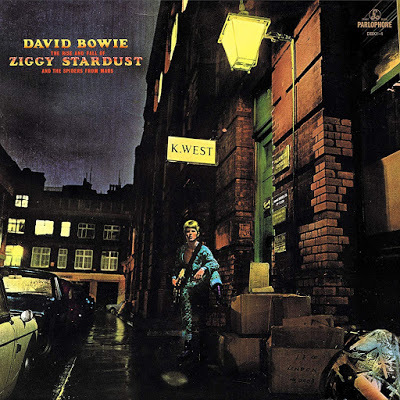 I posted about three of my favorite AM9s. The idea behind AM, or Absolute Magnitude, was to find a way to approximate the intrinsic importance of an LP – to make a rubric that emphasized the objective rather than the subjective. That’s impossible, of course. Many would make AC/DC’s Back in Black a 10, but not me, simply because my biased brain doesn't care for it – I end up bending my own rules. But that kind of conversation (even when it's with myself) is just what I try to inspire in my rock history. I listed three AM9s that others might view as 10s or 6s for that matter, but they are truly breaking the rules. Today I offer an example of an AM10 simply to walk through the rubric – David Bowie's The Rise and Fall of Ziggy Stardust and the Spiders From Mars.
I posted about three of my favorite AM9s. The idea behind AM, or Absolute Magnitude, was to find a way to approximate the intrinsic importance of an LP – to make a rubric that emphasized the objective rather than the subjective. That’s impossible, of course. Many would make AC/DC’s Back in Black a 10, but not me, simply because my biased brain doesn't care for it – I end up bending my own rules. But that kind of conversation (even when it's with myself) is just what I try to inspire in my rock history. I listed three AM9s that others might view as 10s or 6s for that matter, but they are truly breaking the rules. Today I offer an example of an AM10 simply to walk through the rubric – David Bowie's The Rise and Fall of Ziggy Stardust and the Spiders From Mars.All right, let me get this straight, Ziggy Stardust is the story of the human manifestation of an alien being attempting to present humanity with a message of hope in the last five years of its existence, but who unfortunately becomes enamored with sex, drugs, rock 'n' roll and the rabid fans who idolize him. He inevitably burns out and destroys himself. Forget Dune, or even Foundation – this is the perfect dystopian science fiction concept. And because Bowie was so outlandishly alien in his appearance and proclivities, a suspension of disbelief was not required to imagine him in the role. (He was later cast as the believably melancholy alien in The Man Who Fell To Earth.)
But aside from stretching the limits of science-fiction to Rocky Horrific proportions, from the first tentative chords of "Five Years" to the violin and cello outro of "Rock 'n' Roll Suicide," this album packs a galactic wallop. Let's go to the rubric.
Songwriting/Lyrics (2 Points). Not a song here that isn't hummable and the lyrics fit the concept like it was written by Heinlein; Bowie capturing the spirit of the 70s and the sci-fi vibe perfectly. Each of the tracks works as poetry, but it's the opener, "Five Years," and the finale, "Rock 'n' Roll Suicide" that truly shine. It should be noted that Bowie did not write "It Ain't Easy," that was Ray Davies of the Kinks, but even that fits perfectly into the alien rock star persona.
Musicality (2 Points). As a rock 'n' roll LP (not Beatle-esque vaudeville or symphonic prog), critics generally overlook the gutsy band that was the Spiders. Of special note is the rasping, razor-sharp guitar licks of Mick Ronson. There's a healthy dose of acoustic mixed with trademarked glammy blues riffs. Trevor Boulder is no Chris Squire but knew his place in the band and the subtle bass is exactly what it should be. Mick Woodmansey is a drummer’s drummer for the same reason. Add on Rick Wakeman's piano (he had just recently joined Yes) and Bowie’s one-man band, sax included in a time when that was so un-rock, and you easily achieve the 2 points offered under Musicality.
Production (2 Points). Bowie arranged all of the music and co-produced with Ken Scott. While the name is obscure to many, when you hear the grocery list of his productions and LPs on which he was engineer, Scott is quickly elevated to the pantheon of greats: Madman Across the Water, Sgt. Pepper, Beck-Ola, Transformer, while working with Pink Floyd, The Mahavishnu Orchestra, Billy Cobham, The Tubes, you get it. Is it as lush as the production of, as an example, In the Court of the Crimson King? Of course not, but wouldn't the LP lose something if it were? Like a great drummer or bassist, the vanguard of the artform is knowing when to take something off.
I’m not even going to go into the two final categories, Impact and Longevity. Those are obviously givens, and so, The Rise and Fall of Ziggy Stardust and the Spiders From Mars is an AM10. This one is pretty inarguable: Not a bad song on the album.; all but one track written by Bowie; unparalleled musicianship and production; and an LP as impactful today as 50 years ago. Add on extras not covered by the rubric (album cover, iconic photo, the back-cover command: TO BE PLAYED AT MAXIMUM VOLUME, and the incredible concept) and Ziggy approaches an 11,k which, of course, doesn't exist.
Ziggy is head and solders above any of Bowie's previous work, and with a tracklisting which reads like a "greatest hits" collection, this is quite rightfully considered one of the best rock albums of all time. In terms of sound and production, Ziggy is light years ahead of Hunky Dory, itself darn near perfect.
Published on September 11, 2020 08:23
Calif. - Buy This Book!
Get your copy of Calif. by R.J. Stowell at Amazon or read it on your Kindle. And remember, Kindle Unlimited is free the first two month. Thousands of titles from Harry Potter to Lord of the Rings - and Calif., of course! Here's the link.
Watch with sound, share and enjoy!
Signed copy? Contact me at rjsomeone@gmail.com - $12.00 - includes shipping.
Published on September 11, 2020 05:07
September 10, 2020
School's Out
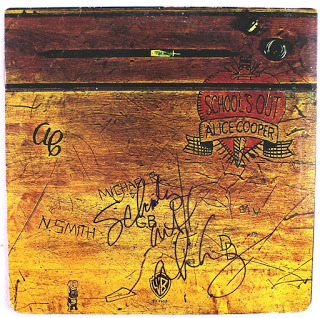
The other day on the radio show, I was asked about my favorite collectibles. Of course, I covet the mint condition Pet Sounds that my wife got for me last Christmas, and my signed copies of Andrew McMahon in the Wilderness, The Tubes, Duran Duran, Wham and The Monkees – but Alice Cooper's School’s Out may be my favorite. Of course, the teen anthem harkens back to my Jr. High School days, but it's the LP cover that makes it my fave. The LP came packaged in an old-fashioned school desk. It was die-cut and had little legs to fold out so that it would stand up. There was a report card with the song titles, but best of all, especially for a 13-year-old boy, the record came wrapped in a pair of pink girls' panties. A good copy like mine will set you back 150 bucks or so.
But there's more! I’d forgotten just how great an album this was. I probably haven't heard it in 40 years. The title track is still as good as it ever was, and the rest of the LP is overlooked, rockin’ and totally fun. It's pretty heavy at times and jazzy others tossing in a bit of Broadway and vaudeville. Love it. I needed something to get me out of Pink Floyd mode (it's been like a month of Floyd); this may be it. Now I want to hear "I'm 18" and "Billion Dollar Babies."
By the way, I have three copies with panties for sale on eBay if anyone is interested. They vary in price based on their condition. Check it out.
Published on September 10, 2020 13:57
September 9, 2020
More on Atom Heart Mother and Pink Floyd
 I've listened to and researched Atom Heart Mother quite a bit in the past week. AM's goal has always been to accentuate the positive in rock history and admittedly we skirt the issues at times. Never have we posted about dismal LPs from great bands or artists such as ELP's Love Beach or Joni Mitchell's Dog Eat Dog, which is truly awful.
I've listened to and researched Atom Heart Mother quite a bit in the past week. AM's goal has always been to accentuate the positive in rock history and admittedly we skirt the issues at times. Never have we posted about dismal LPs from great bands or artists such as ELP's Love Beach or Joni Mitchell's Dog Eat Dog, which is truly awful.And so, we do it times tread softly or circumnavigate negativity by categorizing more succinctly. Such is the case with Pink Floyd. While the Beatles had obvious phases, the early Beatlemania years, mid-career Studio LPs, and the less homogenous LPs that characterized their catalog after Magical Mystery Tour. But that seems more like the band's evolution as they matured.
For Pink Floyd, the iterations were more tied to personnel. Early Floyd, the first two albums, were all about Syd Barrett. From there they carried on in an experimental way without direction creating the soundtracks for More and Obscured By Clouds and the albums Ummagumma and Atom Heart Mother. Obviously, there’s some evolution going on, but I still look at it differently than I do the Beatles. The third phase was classic Floyd. Meddle, Dark Side of the Moon, Wish You Were Here, and Animals, the greatest four in a row in rock music. The 4th phase was the Roger Waters solo phase. This included The Walland The Final Cut. The final phase was Pink Floyd without Waters up to and including 2014's The Endless River.
There are those who would argue with my premise that The Wall and The Final Cut aren't really Pink Floyd albums. And I can indeed argue myself out of it. Despite The Wall being so Roger-centric, it's foolish to assume that the incredible sonic guitar riffs from Gilmore were written by Waters; obviously, that's not the case. And there are many who would argue that Pink Floyd from A Momentary Lapse of Reason onward wasn't Pink Floyd simply because it didn't have Waters. Being on Gilmore‘s team, one cannot dismiss that Waters was the better songwriter and lyricist.
There is no real point to this particular post except to share my thoughts based on a recent venture and re-discovery of Atom Heart Mother. Suffice it to say that here at AM we will continue to extol the virtues of great Floyd but skim over the dreadful Final Cut. I'm enjoying the live LP and video of Pulse, by the way. Here is where I really end up in Gilmore‘s camp. Because Gilmore did the vast majority of vocals and because his guitar is incomparable (while Waters' bass is predictable at best), were I to choose a concert to attend it would be Gilmore’s iteration of Floyd rather than Waters once again rehashing The Wall. Wait, what am I talking about? If it's Floyd time travel we're talking about, I choose Dark Side of the Moon Tour, 1973.
Published on September 09, 2020 17:15



